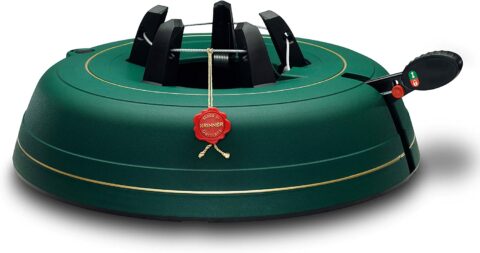
Cats have a natural instinct to climb and when they see a Christmas tree, they may also see a giant scratching post. While it may look cute, climbing or scratching the tree can actually be quite dangerous for your cat. That’s why it’s important to get a good Christmas tree stand that will keep your tree steady and prevent your cat from getting hurt.
A stand that is heavy enough or has a wide base is ideal. You also want to make sure the stand is the right size for your tree. If your stand is too small, your tree may tip over more easily. Read on for our list of the best Christmas tree stands for cats, complete with reviews of each one.
A Glance at Our Winners in 2024
| Image | Product | Details | ||
|---|---|---|---|---|
| Best Overall |

|
Krinner Tree Genie XXL |
|
CHECK PRICE |
| Best Value |

|
Good Tidings Cinco Express Tree Stand |
|
CHECK PRICE |
| Premium Choice |

|
JOHN WRIGHT Heirloom Christmas Tree Stand |
|
CHECK PRICE |

|
JACK-POST Steel Christmas Tree Stand |
|
CHECK PRICE | |

|
National Tree Company Rolling & Folding Tree Stand |
|
CHECK PRICE |
The 10 Best Christmas Tree Stands for Cats
1. Krinner Tree Genie XXL – Best Overall

| Dimensions: | 20 x 20 x 6 inches |
| Weight: | 7 pounds |
| Material: | Metal |
| Capacity: | 2.5 gallons |
If you’re looking for the best Christmas tree stand for your home and happen to have a cat or two, then the Krinner Tree Genie XXL is a clear choice. It’s sturdy and stable, has a large water reservoir, and most importantly, its weight will keep curious cats from toppling over your tree. No assembly is required for the Krinner Tree Genie stand, which accommodates trees up to 12 feet tall. The built-in claws hold your tree in place as you pump the foot pedal until the claws grasp the trunk of the tree.
When the busiest season is upon us, the minutes-long setup saves a great deal of time. This model offers more than that, however. To keep your tree healthy all season long, it has an automatic water level indicator that holds up to 2.5 gallons of liquid. Occasionally, spills can occur due to the basin’s small opening. Despite the high price tag, this stand is worth it for its sturdiness and innovation, which is why we think it’s the best overall Christmas tree stand for cats.
- Simple and attractive design
- Water level indicator included
- An ingenious foot pump mechanism
- Setup is quick and easy
- It’s expensive
- Water opening is narrow
2. Good Tidings Cinco Express Tree Stand – Best Value

| Dimensions: | 20 x 20 x 8 inches |
| Weight: | 2.77 pounds |
| Material: | Plastic |
| Capacity: | 2 gallons |
With this affordable model, you don’t have to sacrifice quality or size just because you don’t want to spend a fortune on a tree stand. There are four galvanized pins in the center of the base of this stand, which holds trees up to 10 feet tall and 6 inches across. Although it’s not quite as easy to set up as our top pick, it’s a solid choice at a reasonable price. It also has some neat added features, such as a 2-gallon reservoir with a deep splash guard to keep any water from spilling outside the base area.
This stand will support the weight of your tree, plus any decorations and lights you plan to add, and doesn’t have any sharp edges that could injure your cat. The Cinco Express Tree Stand is a good, reasonably priced choice for homes with felines and the best Christmas tree stand for cats for the money.
- Easy to install
- Galvanized pins
- Dry floors are ensured by spill guards
- Probably won’t last as long as our top choice
3. JOHN WRIGHT Heirloom Christmas Tree Stand – Premium Choice

| Dimensions: | 17 x 17 x 8 inches |
| Weight: | 16.2 pounds |
| Materials: | Cast iron, nickel, and foam pads |
| Capacity: | 1 quart |
It looks like a Victorian tree stand, but it’s not a refurbished antique. Finished in rust-resistant urethane, it’s made of cast iron and will last a lifetime. Using the three massive brass-plated eye screws, attach the tree to the cylinder (which is integrated into the base). It is important to center the tree correctly and tighten it evenly when setting a tree up in this type of stand. There is a nickel-plated steel bar that can be inserted through the screw eye to help you turn it, and a flange nut on each screw prevents the screw from digging into the tree’s bark.
Finally, foam pads with peel-and-stick adhesive are included. To prevent the feet of the stand from scratching the floor, apply these. While it is a fine stand built to last several generations, it lacks some convenient features and does not have a large water capacity. If you’re a traditionalist and pay attention to the water level, this heavy base is wonderful for a home with cats.
- Heavy base
- Beautiful traditional design
- Foam pads prevent floor scratches
- More expensive than some others
- More difficult to set up
- Requires two pairs of hands
4. JACK-POST Steel Christmas Tree Stand

| Dimensions: | 22.5 x 22.5 x 6.75 inches |
| Weight: | 2.3 pounds |
| Material: | Steel |
| Capacity: | 1.7 gallons |
This is a great Christmas tree stand if you have cats in your home. If you are pitting a larger-than-life Christmas tree against a curious kitty cat, you’re going to need all the help you can get. For grand spruces up to 12 feet tall and 6.5 inches in diameter, this sturdy, welded steel stand will do the trick. Besides its sturdy construction, the stand has a wide base to provide extra stability and four eye bolts that lock massive tree trunks into place.
Additionally, the stand has a 1.7-gallon water reservoir, so you won’t have to spend as much time crouching under the tree to refill it. To prevent premature deterioration, the base is reinforced with zinc-dichromate hardware to prevent rusting.
- A style that is simple and classic
- Setup is quick and easy
- Large capacity
- One person may find setup challenging
- A little more expensive than some others
5. National Tree Company Rolling & Folding Tree Stand

| Dimensions: | 28 x 28 x 9 inches |
| Weight: | 2.25 pounds |
| Material: | Steel |
| Capacity: | Holds artificial trees up to 8 feet tall |
If you have a cat or multiple cats, and you also don’t want a real Christmas tree in your home, then you need to get a good tree stand that can accommodate both. The National Tree Company Rolling and Folding Tree Stand is a great option. It’s made of durable steel, so it can support your tree and keep it safe from any pesky cats that might try to climb it. Whenever you decide on the perfect spot for your fir, the stand’s wheel locks will keep everything firmly planted so you won’t have to worry about it sliding around.
In case you have elaborate plans for your decorations this year, the stand is also available in a 32-inch size to house artificial trees up to 10 feet tall.
- Rolls in place for best tree position
- Folds up for easy storage
- Available in two sizes
- For artificial trees only
6. Good Tidings Cinco Tabletop Christmas Tree Stand

| Dimensions: | 14 x 14 x 8 inches |
| Weight: | 1 pound |
| Material: | Polypropylene |
| Capacity: | 0.79 gallons |
If you have a small tree in an area that is harder for your cat to reach, this tree stand might work. If you need to put this in an area your cat spends a lot of time in, you will need to place additional weight on the base. Bear in mind that support is needed even for small trees to stand upright, but you don’t have to spend nearly as much since they are lighter in weight. It is perfectly appropriate to use a small plastic stand in this case. In spite of the low price and lightweight material, don’t be deterred by the low price.
The stand is made of a polypropylene material that doesn’t break and can withstand low temperatures (perfect for displaying your tree on a porch!), and it has three rust-proof spikes made of tempered steel. It also has a raised bolt post and cut-away sides, so it doesn’t require any bottom branches to be removed.
- Affordability
- Displays well in low temperatures
- Suitable for smaller trees
- Suitable for tabletop displays instead of floors
- May need additional weight at the base
7. Best Choice 360-Degree Rotating Adjustable Christmas Tree Stand

| Dimensions: | 26 x 26 x 7.5 inches |
| Weight: | 3 pounds |
| Material: | Acrylonitrile Butadiene Styrene (ABS) plastic |
| Capacity: | Holds artificial trees up to 7.5 feet tall and up to 80 pounds |
While you decorate the tree or when guests come over, you can have it rotate and swivel so you can show off all the ornaments you put on. With a weight capacity of 80 pounds, this rotating tree stand can support artificial Christmas trees up to 7.5 feet tall. With three built-in outlets at the base, the swivel Christmas tree stand rotates 360 degrees.
When the tree spins in motion, however, the outlets cause a slight knocking sound. This is something some faint music or TV can mask, but without some background noise, it is noticeable.
- The tree can be decorated while it spins
- Three outlets are built-in
- Setup is easy
- A faint rotating sound is heard
- Could make your cat extremely curious

Buyers Guide: How to Select the Best Christmas Tree Stands for Cats
When looking for a Christmas tree stand to use in a home with cats, it is important to consider a few key factors. First, the stand should be made of sturdy material that will not tip over easily. Second, it should have a wide base to provide stability. As well as cat-specific concerns, there are other considerations that go into buying the perfect tree stand for cat-friendly homes. Read on to find out more.
Tree Type
When choosing a Christmas tree for a home with cats, it is important to consider the type of tree and think about whether you’ll have a real or artificial tree. A live tree requires a sturdy stand and a model with a water reservoir to support its weight. Some trees, such as pines, have sharp needles that can hurt your cat if they try to climb them. Other trees, like fir trees, have softer needles that are less likely to hurt your cat. If you’re choosing an artificial tree, most come with stands provided, but you can also choose your own.
Tree Size
When looking for a Christmas tree in a home with cats, it is important to consider the size of the tree. A smaller tree may be more appropriate if there are multiple cats in the household, as they will be less likely to climb or knock over a smaller tree. The tree should also be placed in a safe location, away from any areas where the cats may have access to it. You’ll need a stand that fits your tree’s size, which can range from 3 to 15 feet in height or more. The bigger the tree, the bigger the stand’s base must be to keep it upright.
The size of the tree that can be accommodated by most stands is indicated on the stand. In a home with cats, we recommend getting a stand that is much heavier and sturdier. It’s better to go overboard when balancing the weight and width of the base against the height of the tree.

Material
When purchasing a Christmas tree stand for a home with cats, it is important to consider the material of the stand. A stand made of a sturdy, non-toxic material is ideal. Cat claws can easily puncture and tear thin materials, so a stand made of durable material is necessary to prevent damage to the stand and injury to the cat. Additionally, a stand that is easy to clean and disinfect is important, as cats can carry bacteria and other pathogens on their fur.
Conclusion
This year’s top pick is the Krinner Tree Genie XXL, which gets high marks both for its attractive design and ease of setup, making it a great choice. If you are shopping for a less expensive product, we recommend the Good Tidings Cinco Express Tree Stand. If money is less of a concern, the JOHN WRIGHT Heirloom Christmas Tree Stand is a beautiful piece that will last for generations. All of these Christmas trees stands should stand up to a little light pouncing and batting by your cat.
Featured Image Credit: Georgy Dzyura, Shutterstock
Contents
- A Glance at Our Winners in 2024
- The 10 Best Christmas Tree Stands for Cats
- 1. Krinner Tree Genie XXL – Best Overall
- 2. Good Tidings Cinco Express Tree Stand – Best Value
- 3. JOHN WRIGHT Heirloom Christmas Tree Stand – Premium Choice
- 4. JACK-POST Steel Christmas Tree Stand
- 5. National Tree Company Rolling & Folding Tree Stand
- 6. Good Tidings Cinco Tabletop Christmas Tree Stand
- 7. Best Choice 360-Degree Rotating Adjustable Christmas Tree Stand
- Buyers Guide: How to Select the Best Christmas Tree Stands for Cats
- Conclusion













